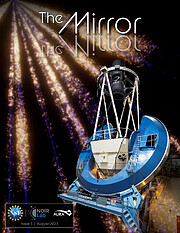August Issue of the NOIRLab Mirror Newsletter Highlights News and Milestones for the NOIRLab Community
29 August 2023
The fifth (August 2023) edition of The NOIRLab Mirror newsletter is now available. This biannual publication focuses on news for the NOIRLab community and showcases the science, technology, and developments across the five NOIRLab Programs: the Community Science and Data Center (CSDC), Cerro Tololo Inter-American Observatory (CTIO), the International Gemini Observatory, Kitt Peak National Observatory (KPNO), and Vera C. Rubin Observatory Operations.
The August 2023 issue features a collection of science highlights spanning the breadth of NOIRLab facilities and Programs, a review of citizen-science research on light pollution, pathways forward for astronomy and satellite constellations, a lookback at Gemini North’s return to operations following the repair of its primary mirror, Rubin Observatory and DEI training, updates on the US Extremely Large Telescope Program, much more.
The NOIRLab Mirror is free and notifications of the release of future electronic issues can be requested here. A free subscription for printed copies can also be requested by libraries and researchers here.
More information
NSF’s NOIRLab (National Optical-Infrared Astronomy Research Laboratory), the US center for ground-based optical-infrared astronomy, operates the international Gemini Observatory (a facility of NSF, NRC–Canada, ANID–Chile, MCTIC–Brazil, MINCyT–Argentina, and KASI–Republic of Korea), Kitt Peak National Observatory (KPNO), Cerro Tololo Inter-American Observatory (CTIO), the Community Science and Data Center (CSDC), and Vera C. Rubin Observatory (operated in cooperation with the Department of Energy’s SLAC National Accelerator Laboratory). It is managed by the Association of Universities for Research in Astronomy (AURA) under a cooperative agreement with NSF and is headquartered in Tucson, Arizona. The astronomical community is honored to have the opportunity to conduct astronomical research on Iolkam Du’ag (Kitt Peak) in Arizona, on Maunakea in Hawai‘i, and on Cerro Tololo and Cerro Pachón in Chile. We recognize and acknowledge the very significant cultural role and reverence that these sites have to the Tohono O’odham Nation, to the Native Hawaiian community, and to the local communities in Chile, respectively.
Contacts
Charles Blue
Public Information Officer
NSF NOIRLab
T: +1 202 236 6324
Email: charles.blue@noirlab.edu






